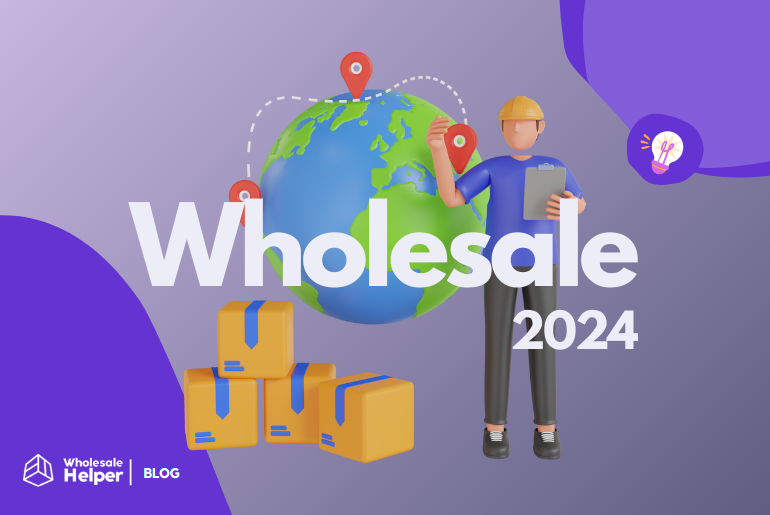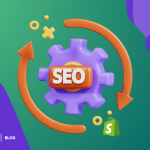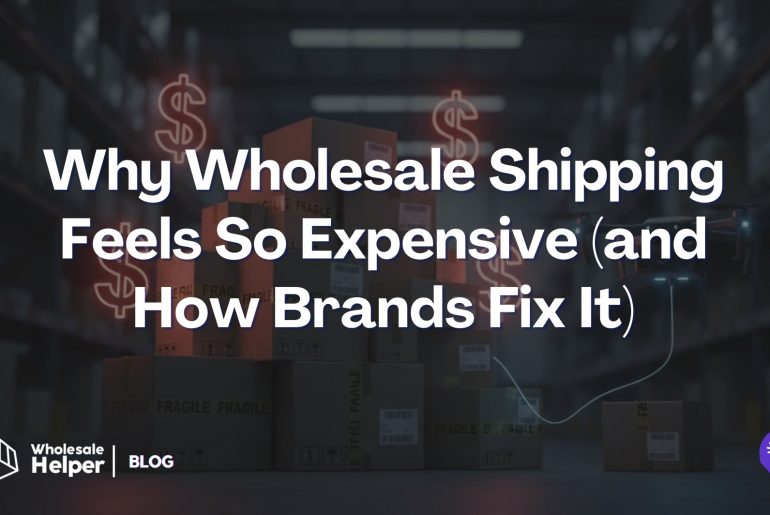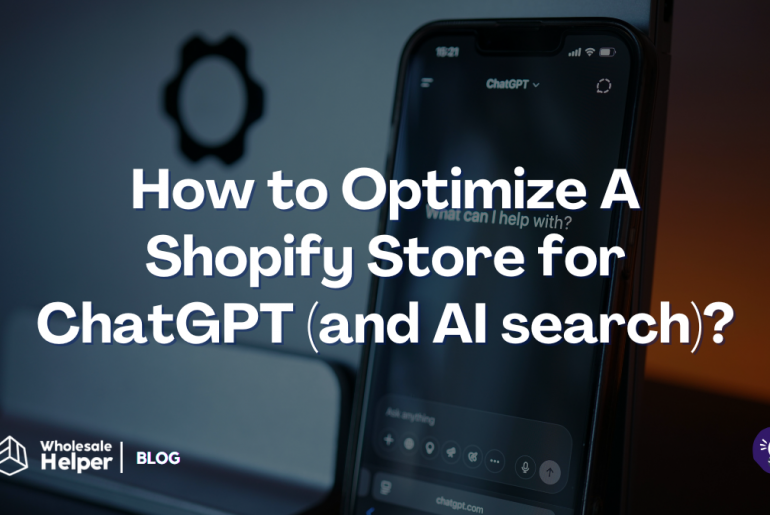Starting a wholesale business online in 2025 can be a great opportunity for entrepreneurs to tap into a market with bigger clients, higher order values, and more revenue. With more and more digital e-commerce platforms today, it has become extremely easy for anyone to start a B2B e-commerce business. You can source products easily from any part of the world, and sell them to another while managing all this seamlessly with the powerful e-commerce stacks that are present today.
Selling wholesale or B2B online offers tons of benefits, though it requires you to set up several additional features over retail selling. In this guide, we will discuss starting a wholesale business online. We will understand the difference between retail and wholesale, the difference between selling wholesale on the marketplace vs having your website, the steps to set up wholesale on your store, and more.
So let’s start!
- Understanding the Wholesale Business Model
- How selling wholesale online is different from selling retail online?
- Ways of selling wholesale online – Marketplace vs Your own site
- 7 steps to start a wholesale business online
- Best platforms to create a wholesale website in 2024
- Best platforms to create a wholesale website in 2024
- Summing up
- Frequently Asked Questions
Understanding the Wholesale Business Model
The wholesale business model revolves around buying products in large quantities directly from manufacturers or distributors and selling them in bulk to retailers or other businesses, or stores. Unlike retail, where the per-unit price of products is higher as consumers only buy for themselves, wholesale business involves lower per-unit prices but higher order quantities. These large quantity orders enable wholesalers to generate more even with lower profit margins per product.
With powerful e-commerce platforms present today, it’s no surprise that in 2025, more than 33% of the world’s population will be shopping online. With this growing trend of e-commerce, manufacturers and wholesalers are rapidly shifting online to provide a platform where customers prefer to buy from.

How is selling wholesale online different from selling retail online?
The major difference between selling wholesale and retail is that retail involves selling products to individual consumers whereas on the other hand, whereas wholesale involves selling products to other retailers or businesses who resell them later. Let us compare the two businesses in detail.
| Aspect | Retail | Wholesale |
| Customer Base | Individual consumers | Businesses/Retailers |
| Order Volume | Small quantities, single or few items per order | Large quantities/bulk volume |
| Customer Shopping Experience | Standard across the entire store | Requires personalisation based on different customer needs and purchasing patterns. |
| Payment Terms | Generally involves immediate payment | Might include net payment terms (e.g., 30, 60, 90 days) |
| Pricing Strategy | Higher per-unit prices | Lower per-unit prices, volume discounts |
| Sales Cycle | Shorter, generally quick transactions | Longer, involves negotiations, and building relationships |
| Customer Relationships | Short-term, one-time or occasional purchases | Long-term relationships, repeat business |
| Exclusive Products | Generally, all products sitewide are available for all B2C customers | There might be a need to show specific products to only specific customers |
| Logistics and Shipping charges | Simpler, direct-to-consumer fulfillment and standard shipping rates | Complex and advanced shipping rates are required based on order quantities, weight, etc. |
Read Also
- B2B Wholesale – The Ultimate Guide
- How To Buy Wholesale Products to Resell on Your Shopify? [6 Easy Steps]
Ways to start selling wholesale online – Marketplace vs Your site
When you are deciding to sell online, one of the most crucial steps is to choose the right platform that aligns with the specific goals of your business. There are majorly two ways to sell wholesale online. You can either start selling on marketplaces like Amazon, eBay, Faire, etc, or make your own online e-commerce website.
Selling wholesale on Marketplace
Advantages
- Wide audience reach – Marketplaces like Amazon, Alibaba, eBay, and Faire, have a large existing audience of buyers that surf the platforms looking for products they need. This means you can start to get customers without putting in extensive marketing efforts yourself.
- Credibility of marketplaces – Buyers often trust well-known marketplaces due to their established reputation and security measures.
- Easy setup – Setting up a seller account on a marketplace is usually straightforward as marketplaces offer a simple onboarding process for businesses.
- Traffic and marketing – Marketplaces handle a significant amount of the marketing themselves and drive traffic to the site. This reduces the marketing effort that you have to do on your end.
- Payment processing – Marketplaces often manage payment processing themselves so that you don’t have to handle the complexity and risk of handling financial transactions.
Disadvantages
- Fees and commissions – When you sell products on the marketplace, you have to pay different kinds of fees to the platform. These include transaction fees, listing fees, and the commission you have to share on every product sold. These fees significantly affect the profit that you make. For instance, Amazon deferred transactions impact cash flow, as payments are held for a specific period before being released, which can require sellers to plan their finances carefully.
- No unique branding – Customizing your store’s appearance and building a unique brand identity can be challenging on a marketplace platform.
- Competition – You’ll be competing with many other sellers offering similar products which will make it super hard to stand out. Also, the scope and features provided by marketplaces for marketing within the platform are limited.
- Lesser control – Marketplaces have strict rules and policies that sellers must adhere to which limits your control over certain aspects of your business.
Selling wholesale on your own site
Advantages
- Branding control – Having your own site allows you to fully customize the design, layout, and branding, which helps you create a unique shopping experience and a brand that customers will remember and shop from in the future.
- No marketplace fees – You avoid the fees associated with selling on a marketplace which allows you to keep the profits with your business and thus increase your profit margins.
- More control – You have complete control over your site’s functionality, product listings, pricing strategies, and sales policies.
- Direct contact with customers – Direct interaction with your customers allows for better relationship building, personalized marketing, and improved customer loyalty.
- SEO and marketing – Investing in SEO and digital marketing for your site can build long-term organic traffic and brand recognition.
Disadvantages
- Setup costs – Building your own e-commerce site involves upfront costs for web development, hosting, design, and other miscellaneous expenses that you have to pay for.
- Marketing and traffic generation – Though you have more control over your marketing operations, you have to put in the effort to drive traffic to your store. For e-commerce stores today, you have to invest significantly in digital marketing which again adds to your cost of customer acquisition.
- Technical maintenance – Managing your own site requires ongoing technical maintenance and updates to ensure the smooth functioning of your store.
- Payment methods – You’ll need to set up and manage payment processing systems, as well as ensure your site’s security to protect customer data.
Ready to impress your B2B customers? Start wholesaling like a pro! 🙂
Try our Wholesale Pricing Discount app for free !
8 steps to start a wholesale business online
1. Find the best wholesale products to sell online
The first step is to conduct market research and find out the best wholesale products to sell online which have high demand, easy sourcing processes, low maintenance inventory processes, and high-profit margins.
You can use tools like Google Trends and other e-commerce reports to understand the products that are in high demand and have good profit margins to ensure more sales for your store.
Try to look for products that solve common problems, cater to specific interests, or are everyday essentials, as this will ensure that the demand is consistent irrespective of changing market conditions.
2. Legalities and business setup
The next step is to understand the legalities and set up the business correctly as per its category. Different regions will have different business types, such as sole proprietorship, partnership, limited liability company (LLC), and private limited company.
Choose the structure that best fits your business model. Once selected, you have to then register your business with the appropriate government authorities, choose a business name, complete necessary paperwork, etc.
Additionally, you need to ensure that you comply with all tax obligations and e-commerce regulations in your region. This includes understanding your income tax, sales tax, VAT, GST, etc. You will also need to set up a consumer privacy policy and shopping terms and conditions for your business.
3. Source products from manufacturers
Research and connect with suppliers or manufacturers to source the products that you want to sell. You can choose products from sourcing websites like AliExpress, Alibaba, DHgate, etc. Stores in the United States can use platforms like United States Wholesale to find wholesalers and product manufacturers.
Before committing, ensure that you thoroughly vet suppliers by checking reviews, requesting samples, and verifying their business credentials. Also, try to find multiple suppliers and negotiate the sourcing price of the products. Also set up clear agreement terms, including minimum order quantities, delivery schedules, and payment terms to ensure that things run smoothly for both you and the supplier.
4. Choose a platform to create your site
The next step for you is to choose where you want to sell your products online, it could be a marketplace or your own site depending on the specific needs of your wholesale business.
If you decide to build your own site then Shopify is one of the best platforms for that. You can set up features with wholesale capabilities on your store using the Shopify Plus plan or by installing 3rd party wholesale apps for Shopify which is an economical alternative for the same.
6. Customised pricing strategy
Unlike B2C selling where generally there is standard pricing for all the customers, in wholesale or B2B selling, you have to set up customised pricing for different customers and offer deals like combining discounts, volume discounts, tiered pricing, and more.
Volume discounts reward customers who purchase in larger quantities and this encourages bulk orders and increases overall sales. Tiered pricing allows you to set different price levels based on the quantity purchased and this provides better rates for higher volumes.
5. Install Wholesale Pricing Discount on Shopify

Shopify is one of the most powerful platforms today to sell wholesale online. Moreover, using apps like Wholesale Pricing Discount available on the Shopify app store, users can create customised pricing and discounts, offer bulk discounts, create wholesale sign-up form, offer net payment terms, set up advanced shipping rates and more.
Plus, the app now allows you to take your wholesale business global by its recently launched Global Plan. Using the global plan, you can start selling B2B to customers beyond your geography without worrying about the associated operations headaches as the app takes care of most of it.
7. Enable bulk ordering on your store
When you are selling wholesale online on your store, you need to ensure that your customers find it super convenient to order products in bulk quantities from you. You can enable this by incorporating a bulk order form in your store.
Not having a bulk order form will require customers to manually go and add products one by one. This process can be super frustrating it involves a lot of back-and-forth movement between pages selecting products and their quantities. A bulk-order form provides a seamless shopping experience for bulk buyers.
8. Set up net payment terms
When you sell wholesale in your store, you have to set up and provide flexible payment terms to your customers. This is done by offering net payment terms like Net 30, 60, and 90, meaning customers can pay for the order in a set time frame in future. Offering net terms helps both the wholesaler and the retailer to maintain a healthy cash flow in their business.
Best platforms to create a wholesale website in 2025
If you want more control and choose to create your own store for selling wholesale online, below we will discuss some of the best platforms for you to choose from.

- Shopify – Today, Shopify has become one of the biggest e-commerce platforms millions of websites using it in 2025. Shopify is best known for its easy set-up and user-friendly interface. Using Shopify Plus, (their upgraded plan) you can set up your wholesale store with multiple features like custom pricing and discounts, wholesale shipping rates, net payment terms, and more.
Another strong advantage of Shopify is its app store where you can find thousands of useful apps that you can install for your business’s specific needs. Moreover, as for small businesses, the Shopify Plus plan can be on the costlier side, but by using different wholesale apps on Shopify, you can set up the same features in an economical way. - WooCommerce – WooCommerce is an e-commerce plugin/app for websites that are made on WordPress. WooCommerce allows users to set up e-commerce on their WordPress website. The platform offers great flexibility and customization through numerous plugins and themes. WooCommerce is a cost-effective platform and also has a large community for support, but it requires technical knowledge for setup and maintenance.
- BigCommerce – BigCommerce is known for its pre-existing B2B functionalities, API capabilities, and strong SEO tools. A lot of big e-commerce businesses have been built and scaled on BigCommerce. However, compared to Shopify, it’s a little tricky to understand and get started with.
- Magento Commerce – Magento Commerce is a platform by Adobe which is a highly customizable e-commerce platform. Magento is suitable for large-scale wholesale businesses. It offers a good number of B2B features, multi-store management, and solid SEO features. While it provides extensive functionality it also requires good technical knowledge to make the most out of the platform.
Ready to impress your B2B customers? Start wholesaling like a pro! 🙂
Try our Wholesale Pricing Discount app for free !
Summing up
Starting a wholesale business online in 2025 can bring in a lot of opportunities and help entrepreneurs tap the B2B wholesale market, where they could generate higher average order values and add more revenue to their business. The evolution of e-commerce platforms has been superfast, and Shopify is leading the change as it is one of the easiest to use platforms to create an online store today.
You can use the Shopify Plus plan to set up a wholesale store online, or you can install apps like Wholesale Pricing Discount, Wholesale Lock Manager, and WSH Order Form & ReOrder to set up all the features of wholesale at a much lower cost. You can follow the above-mentioned steps to set up your wholesale store online on Shopify and start selling wholesale today!
Frequently Asked Questions
How do I determine if there is demand for my wholesale products?
You can use tools like Google Trends and industry reports to find out popular products for your wholesale business. Additionally you can analyse what competitors are offering and the customer reviews on them to gauge interest.
How do i find wholesalers for my online business?
To find wholesalers for your online business, research reliable sourcing platforms like AliExpress, Alibaba, and DHgate. Additionally you can attend join B2B marketplaces, and network within your industry to discover reputable suppliers.
How do I find B2B buyers online?
To find B2B buyers online you can use platforms like LinkedIn to connect with industry professionals and join relevant groups. You can also check online forums and B2B marketplaces such as Alibaba and Global Sources. You can also use facebook lead ads to collect details on interested B2B buyers.
How do I handle returns and exchanges in a wholesale business?
Before starting, you have to establish a clear return policy, communicate it to your clients, and work with suppliers to manage returns and exchanges effectively. Also keep records of returns to identify any recurring issues with products.
What is the importance of a minimum order quantity (MOQ) in wholesale?
MOQs help ensure profitability by covering production costs and managing inventory levels efficiently. They also help maintain a balance between supply and demand. Setting appropriate MOQs can help you increase your average order value.










1 Comment
Inquiry About Opening a Wholesale Account
Hello, I’m interested in learning more about setting up a wholesale account with your brand to offer your products. Could you let me know what information or documents are required from my business to begin the process? I am ready to provide all the documents you need for your reference, and my contact details are listed below. Thanks!